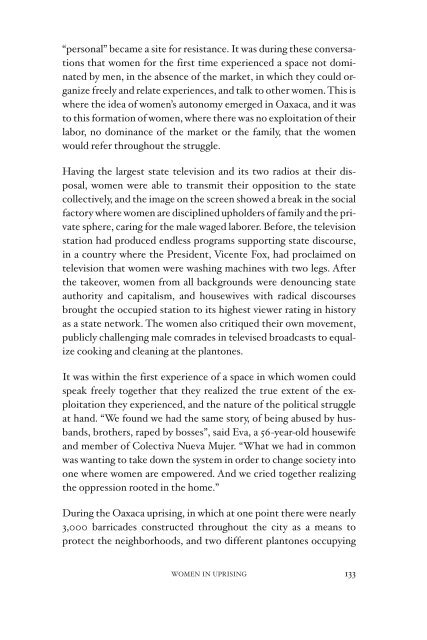Lies: A Journal of Materialist Feminism - Libcom
Lies: A Journal of Materialist Feminism - Libcom
Lies: A Journal of Materialist Feminism - Libcom
You also want an ePaper? Increase the reach of your titles
YUMPU automatically turns print PDFs into web optimized ePapers that Google loves.
“personal” became a site for resistance. It was during these conversations<br />
that women for the first time experienced a space not dominated<br />
by men, in the absence <strong>of</strong> the market, in which they could organize<br />
freely and relate experiences, and talk to other women. This is<br />
where the idea <strong>of</strong> women’s autonomy emerged in Oaxaca, and it was<br />
to this formation <strong>of</strong> women, where there was no exploitation <strong>of</strong> their<br />
labor, no dominance <strong>of</strong> the market or the family, that the women<br />
would refer throughout the struggle.<br />
Having the largest state television and its two radios at their disposal,<br />
women were able to transmit their opposition to the state<br />
collectively, and the image on the screen showed a break in the social<br />
factory where women are disciplined upholders <strong>of</strong> family and the private<br />
sphere, caring for the male waged laborer. Before, the television<br />
station had produced endless programs supporting state discourse,<br />
in a country where the President, Vicente Fox, had proclaimed on<br />
television that women were washing machines with two legs. After<br />
the takeover, women from all backgrounds were denouncing state<br />
authority and capitalism, and housewives with radical discourses<br />
brought the occupied station to its highest viewer rating in history<br />
as a state network. The women also critiqued their own movement,<br />
publicly challenging male comrades in televised broadcasts to equalize<br />
cooking and cleaning at the plantones.<br />
It was within the first experience <strong>of</strong> a space in which women could<br />
speak freely together that they realized the true extent <strong>of</strong> the exploitation<br />
they experienced, and the nature <strong>of</strong> the political struggle<br />
at hand. “We found we had the same story, <strong>of</strong> being abused by husbands,<br />
brothers, raped by bosses”, said Eva, a 56-year-old housewife<br />
and member <strong>of</strong> Colectiva Nueva Mujer. “What we had in common<br />
was wanting to take down the system in order to change society into<br />
one where women are empowered. And we cried together realizing<br />
the oppression rooted in the home.”<br />
During the Oaxaca uprising, in which at one point there were nearly<br />
3,000 barricades constructed throughout the city as a means to<br />
protect the neighborhoods, and two different plantones occupying<br />
WOMEN IN UPRISING 133

















